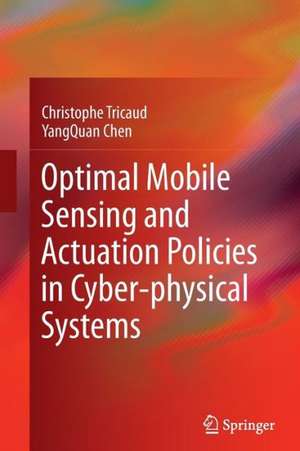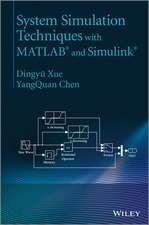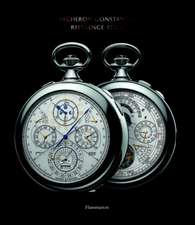Optimal Mobile Sensing and Actuation Policies in Cyber-physical Systems
Autor Christophe Tricaud, YangQuan Chenen Limba Engleză Paperback – 30 noi 2013
| Toate formatele și edițiile | Preț | Express |
|---|---|---|
| Paperback (1) | 635.15 lei 6-8 săpt. | |
| SPRINGER LONDON – 30 noi 2013 | 635.15 lei 6-8 săpt. | |
| Hardback (1) | 635.01 lei 6-8 săpt. | |
| SPRINGER LONDON – 15 oct 2011 | 635.01 lei 6-8 săpt. |
Preț: 635.15 lei
Preț vechi: 747.23 lei
-15% Nou
Puncte Express: 953
Preț estimativ în valută:
121.54€ • 127.15$ • 100.96£
121.54€ • 127.15$ • 100.96£
Carte tipărită la comandă
Livrare economică 02-16 aprilie
Preluare comenzi: 021 569.72.76
Specificații
ISBN-13: 9781447161431
ISBN-10: 1447161432
Pagini: 188
Ilustrații: XVIII, 170 p.
Dimensiuni: 155 x 235 x 10 mm
Greutate: 0.27 kg
Ediția:2012
Editura: SPRINGER LONDON
Colecția Springer
Locul publicării:London, United Kingdom
ISBN-10: 1447161432
Pagini: 188
Ilustrații: XVIII, 170 p.
Dimensiuni: 155 x 235 x 10 mm
Greutate: 0.27 kg
Ediția:2012
Editura: SPRINGER LONDON
Colecția Springer
Locul publicării:London, United Kingdom
Public țintă
ResearchCuprins
Introduction.- Distributed Parameter Systems: Controllability, Observability and Identification.- Optimal Heterogeneous Mobile Sensing for Parameter Estimation of Distributed Parameter Systems.- Optimal Mobile Remote Sensing Policies.- On-line Optimal Mobile Sensing Policies: Finite-horizon Control Framework.- Optimal Mobile Actuation/Sensing Policies for Parameter Estimation off Distributed Parameter Systems.- Optimal Mobile Sensing with Fractional Sensor Dynamics.- Optimal Mobile Remote Sensing Policy for Downscaling and Assimiliation Problems.- Conclusions and Future Work.- Appendices: Notation; RIOTS Tutorial; Implentations.
Notă biografică
Dr. YangQuan Chen has authored over 200 academic papers plus numerous technical reports. He co-authored two textbooks:"System Simulation Techniques with MATLAB®/Simulink" (with Dingyu Xue. Tsinghua University Press, April’02, ISBN 7-302-05341-3/TP3137, in Chinese) and "Solving Advanced Applied Mathematical Problems Using Matlab" (with Dingyu Xue. Tsinghua University Press. August’04. 419 pages in Chinese, ISBN 7-302-09311-3/O.392); and five research monographs: "Plastic Belt for Projectiles" (with Y. Shi. Shaanxi Science and Technology Press, Jan. 1995, ISBN 7-5369-2277-9/TJ.1, in Chinese), "Iterative Learning Control" (with C. Wen. LNCIS, Springer-Verlag, Nov. 1999, ISBN: 1-85233-190-9), “Iterative Learning Control” (with Hyo-Sung Ahn and Kevin L. Moore. Springer, July’07, ISBN: 978-1-84628-846-3), “Optimal Observation for Cyber-physical Systems”(with Zhen Song, Chellury Sastry and Nazif Tas. Springer, July’09, ISBN: 978-1-84882-655-7), and “Fractional-order Systems and Controls” (with Concepción A. Monje, Blas M. Vinagre, Dingyu Xue and Vicente Feliu, ISBN:978-1-84996-334-3). His current research interests include autonomous navigation and intelligent control of a team of unmanned ground vehicles, machine vision for control and automation, distributed control systems (MAS-net: mobile actuator-sensor networks), fractional-order control, interval computation, and iterative/repetitive/adaptive learning control. Currently, he serves as an Associate Editor for IEEE CSSCEB. He was also an Associate Editor of ISA Review Board for AACC's American Control Conference (ACC’05). He has been the Co-Organizer and Instructor of the Tutorial Workshops on “Fractional-order Calculus in Control and Robotics” at IEEE 2002 Conference on Decision and Control (CDC’02), and “Applied Fractional Calculus in Controls and Signal Processing” at CDC’10 and a founding member of the ASME subcommittee on “Fractional Dynamics”.
Textul de pe ultima copertă
A successful cyber-physical system, a complex interweaving of hardware and software in direct interaction with some parts of the physical environment, relies heavily on proper identification of the, often pre-existing, physical elements. Based on information from that process, a bespoke “cyber” part of the system may then be designed for a specific purpose. Optimal Mobile Sensing and Actuation Strategies in Cyber-physical Systems focuses on distributed-parameter systems the dynamics of which can be modelled with partial differential equations. Such systems are very challenging to measure, their states being distributed throughout a spatial domain. Consequently, optimal strategies are needed and systematic approaches to the optimization of sensor locations have to be devised for parameter estimation.
The text begins by reviewing the newer field of cyber-physical systems and introducing background notions of distributed parameter systems and optimal observation theory. New research opportunities are then defined within this framework. Two important problems considered are optimal mobile sensor trajectory planning and the accuracy effects and allocation of remote sensors. These are followed up with a solution to the problem of optimal robust estimation. Actuation strategies are then introduced into the framework with the purpose of improving estimation and optimizing the trajectories of both mobile sensors and mobile actuators simultaneously. The large number of illustrations within the text will assist the reader to visualize the application of the methods proposed. A group of similar examples are used throughout the book to help the reader assimilate the material more easily.
Under a given cyber-physical systems infrastructure, communications abilities of mobile sensors and/or mobile actuators may be needed, and this can beconsidered within the framework presented in this text. Application examples cover fields from environmental science to national security so that readers are encouraged to link the ideas of cyber-physical systems with their own research.
The text begins by reviewing the newer field of cyber-physical systems and introducing background notions of distributed parameter systems and optimal observation theory. New research opportunities are then defined within this framework. Two important problems considered are optimal mobile sensor trajectory planning and the accuracy effects and allocation of remote sensors. These are followed up with a solution to the problem of optimal robust estimation. Actuation strategies are then introduced into the framework with the purpose of improving estimation and optimizing the trajectories of both mobile sensors and mobile actuators simultaneously. The large number of illustrations within the text will assist the reader to visualize the application of the methods proposed. A group of similar examples are used throughout the book to help the reader assimilate the material more easily.
Under a given cyber-physical systems infrastructure, communications abilities of mobile sensors and/or mobile actuators may be needed, and this can beconsidered within the framework presented in this text. Application examples cover fields from environmental science to national security so that readers are encouraged to link the ideas of cyber-physical systems with their own research.
Caracteristici
Shows the reader how to optimize the positions of networked sensors to model challenging distributed-parameter systems Demonstrates how cyber-physical systems can be used in applications from environmental science to national security Extensive use of illustrations and related examples helps the reader to assimilate the ideas presented Includes supplementary material: sn.pub/extras












